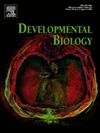Centriolar defects underlie a primary ciliary dyskinesia phenotype in an adenylate kinase 7 deficient ciliated epithelium
IF 2.5
3区 生物学
Q2 DEVELOPMENTAL BIOLOGY
引用次数: 0
Abstract
The skin of Xenopus embryos contains numerous multiciliated cells (MCCs), which collectively generate a directed fluid flow across the epithelial surface essential for distributing the overlaying mucous. MCCs develop into highly specialized cells to generate this flow, containing approximately 150 evenly spaced centrioles that give rise to motile cilia. MCC-driven fluid flow can be impaired when ciliary dysfunction occurs, resulting in primary ciliary dyskinesia (PCD) in humans. Mutations in a large number of genes (∼50) have been found to be causative to PCD. Recently, studies have linked low levels of Adenylate Kinase 7 (AK7) gene expression to patients with PCD; however, the mechanism for this link remains unclear. Additionally, AK7 mutations have been linked to multiple PCD patients. Adenylate kinases modulate ATP production and consumption, with AK7 explicitly associated with motile cilia. Here we reproduce an AK7 PCD-like phenotype in Xenopus and describe the cellular consequences that occur with manipulation of AK7 levels. We show that AK7 localizes throughout the cilia in a DPY30 domain-dependent manner, suggesting a ciliary function. Additionally, we find that AK7 overexpression increases centriole number, suggesting a role in regulating centriole biogenesis. We find that in AK7-depleted embryos, cilia number, length, and beat frequency are all reduced, which in turn significantly decreases the tissue-wide mucociliary flow. Additionally, we find a decrease in centriole number and an increase in sub-apical centrioles, implying that AK7 influences both centriole biogenesis and docking, which we propose underlie its defect in ciliogenesis. We find that both the AK domain and the DPY30 domain are required for proper centriole regulation. We propose that AK7 plays a role in PCD by impacting centriole biogenesis and apical docking, ultimately leading to ciliogenesis defects that impair mucociliary clearance.
在腺苷酸激酶7缺陷纤毛上皮中,新的中心粒缺陷是原发性纤毛运动障碍表型的基础。
非洲爪蟾胚胎的皮肤包含许多多纤毛细胞(mcc),它们共同在上皮表面产生定向流体流动,这对分布覆盖的粘液至关重要。mcc发育成高度特化的细胞来产生这种流动,包含大约150个均匀间隔的中心粒,产生可运动的纤毛。当纤毛功能障碍发生时,mcc驱动的液体流动可能受损,导致人类原发性纤毛运动障碍(PCD)。大量基因(约50个)的突变已被发现导致PCD。最近,研究将低水平的腺苷酸激酶7 (AK7)基因表达与PCD患者联系起来;然而,这种联系的机制尚不清楚。此外,AK7突变与多个PCD患者有关。腺苷酸激酶调节ATP的产生和消耗,AK7与运动性纤毛明显相关。在这里,我们在爪蟾中再现了AK7的pcd样表型,并描述了AK7水平的操纵所发生的细胞后果。我们发现AK7以DPY30结构域依赖的方式定位于整个纤毛,这表明AK7具有纤毛功能。此外,我们发现AK7过表达增加了中心粒数量,提示其在调节中心粒生物发生中起作用。我们发现,在ak7缺失的胚胎中,纤毛数量、长度和跳动频率都减少了,这反过来又显著减少了组织范围内的粘液纤毛流量。此外,我们发现中心粒数量减少,亚根尖中心粒增加,这意味着AK7影响中心粒的生物形成和对接,我们认为这是AK7在纤毛发生中缺陷的基础。我们发现AK结构域和DPY30结构域都是中心粒调控所必需的。我们认为AK7通过影响中心粒生物发生和根尖对接在PCD中发挥作用,最终导致纤毛发生缺陷,损害纤毛粘膜清除。
本文章由计算机程序翻译,如有差异,请以英文原文为准。
求助全文
约1分钟内获得全文
求助全文
来源期刊

Developmental biology
生物-发育生物学
CiteScore
5.30
自引率
3.70%
发文量
182
审稿时长
1.5 months
期刊介绍:
Developmental Biology (DB) publishes original research on mechanisms of development, differentiation, and growth in animals and plants at the molecular, cellular, genetic and evolutionary levels. Areas of particular emphasis include transcriptional control mechanisms, embryonic patterning, cell-cell interactions, growth factors and signal transduction, and regulatory hierarchies in developing plants and animals.
 求助内容:
求助内容: 应助结果提醒方式:
应助结果提醒方式:


